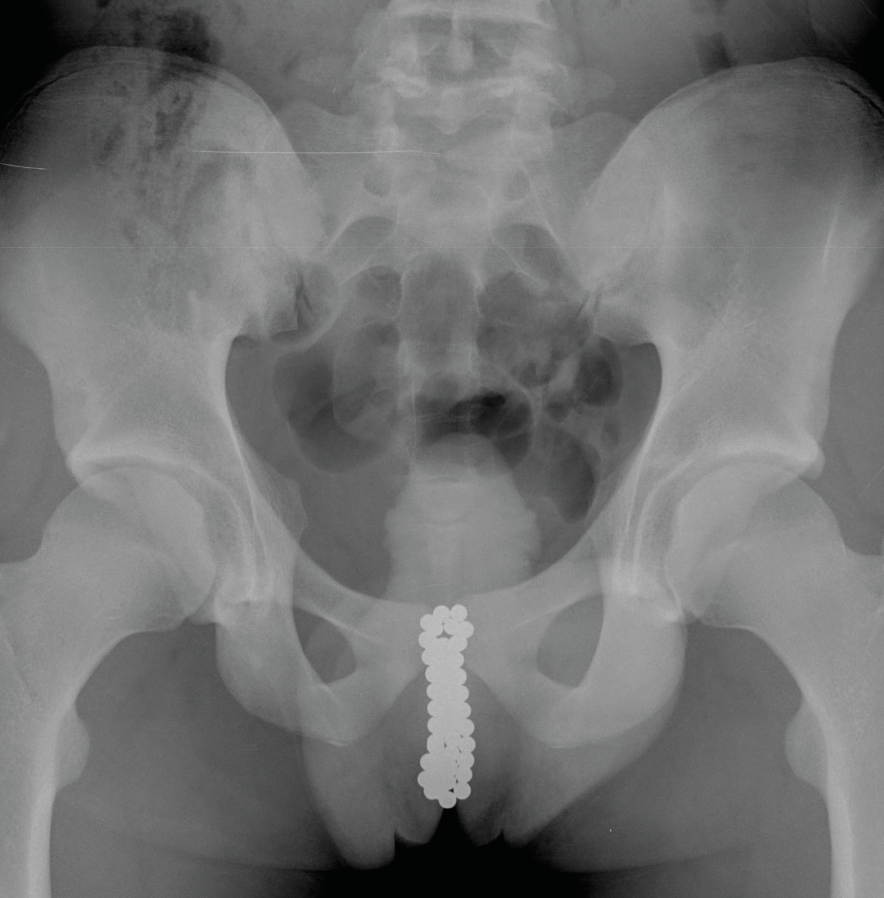The Pull of Buckyballs: A Teen’s Urethral Insertion of Strong Magnets
Lawrence M. Wyner, MD
A 17-year-old young man presented to the emergency department shortly after having inserted several dozen spherical rare-earth toy magnets (Buckyballs) into his urethra, presumably for self-stimulation purposes (Figure 1).
The son of two physicians, the patient was an honors student–athlete at a local private high school who aspired to become an orthopedic surgeon.
Aside from his taking daily dexmethylphenidate for attention-deficit/hyperactivity disorder, his past medical history was unremarkable.

Figure 1. The cluster of magnetic balls was pushed from the urethra into the bladder, and the magnets then were removed one by one using a cystoscope sheath and biopsy forceps.
The Challenge of Removal
An attempt was made to remove the string of Buckyballs by exerting gentle traction on the tail end of the chain (Figure 2). However, the internal string of balls had contorted inside the bulbar urethra; thus, the chain separated at the meatus during the removal attempt, leaving approximately 50 balls inside the urethra (Figure 3).
The patient was taken to the cystoscopy suite and placed under general anesthesia. Each of the magnetic balls was removed individually over the next 3 hours using a 22-French cystoscope sheath and cold cup biopsy forceps. To aid recovery, the tangled mass was pushed up into the bladder and then the spheres teased apart one by one until all of them had been extracted.
A catheter was placed overnight; following its removal the next morning, the patient made an uneventful recovery and was discharged home.

Figure 2. Radiograph at presentation showing a string of several dozen individual magnetic Buckyballs in the urethra of a 17-year-old boy.
Discussion
In 2012, the U.S. Consumer Product Safety Commission (CPSC) brought about a ban on the small but powerful rare-earth toy magnets marketed under the name Buckyballs.1
This product is manufactured in China from a nickel-plated alloy of neodymium, iron, and boron. Buckyballs look like harmless BBs, measuring approximately 4 mm in diameter, but these magnets are 10 times stronger than ordinary magnets of the same size. It is now illegal under federal law for any person to sell, offer for sale, manufacture, distribute in commerce, or import into the United States any Buckyballs.1 Nevertheless, more than 500 million Buckyballs are unaccounted for in the United States since their introduction in 2009 and are in the process of being recalled.
If ingested, the magnetic balls are powerful enough to damage tissue, and sometimes open surgery is required remove them2; cases of bowel necrosis have been reported.3,4 While the majority of ingestions have involved the gastrointestinal tract, other cases of urogenital tract Buckyball insertion also have been reported.5
Two aspects of the case presented here are notable: First, the patient was not mentally or physically challenged, as is the case in many such situations,6 which in extreme cases can lead to self-mutilation. In fact, this patient was an honors student. Second, we were able to remove the Buckyballs without resorting to open or percutaneous surgery. While the successful nonsurgical treatment of this patient by no means trivializes the seriousness of the problem, this case shows that with persistence, it is possible to remove these magnetic foreign bodies with minimal morbidity.

Figure 3. Approximately 50 magnetic balls remained in the teenager’s urethra after attempted removal with gentle traction.
The Backstory of the Ban
The legal battles that accompanied the marketing and subsequent denouement of Buckyballs serve as an interesting backdrop to their medical implications.7,8
The primary U.S. importer of Buckyballs, based in New York City, maintained until the end that the CPSC in actuality was battling the free market. The importer instead pointed to personal and parental responsibility, citing the potential dangers posed by many common household items that can result in injury if they are used improperly or without appropriate supervision.
Nevertheless, the combination of a bored teenager, a rainy Sunday afternoon, and Buckyballs spelled trouble for our patient that day.
Lawrence M. Wyner, MD, is a professor of urology in the Department of Surgery at the Joan C. Edwards School of Medicine at Marshall University in Huntington, West Virginia.
References
1. Buckyballs and Buckycubes high-powered magnet sets recalled due to ingestion hazard; Craig Zucker to fund a recall trust, settles with CPSC [news release]. Washington, DC: CPSC; May 12, 2014. http://www.cpsc.gov/en/Newsroom/News-Releases/2014/Buckyballs-and-Buckycubes-High-Powered-Magnet-Sets-Recalled/. Accessed June 25, 2015.
2. Kosut JS, Johnson SM, King JL, Garnett G, Woo RK. Successful treatment of rare-earth magnet ingestion via minimally invasive techniques: a case series. J Laparoendosc Adv Surg Tech A. 2013;23(4):405-408.
3. Brown DJ. Small bowel perforation caused by multiple magnet ingestion. J Emerg Med. 2010;39(4):497-498.
4. Ng E, Bradbury RI, Khan N. Case report of bowel perforation after metallic ‘Buckyball’ ingestion. ANZ J Surg. 2013;83(6):489-490.
5. Alyami F, Himmelman J, Whelan T. A magnetic mass within the bladder. Can J Urol. 2013;20(5):6962-6963.
6. Balcı U, Horsanalı MO, Kartalmış M, Girgin C, Dinçel Ç. An unusual foreign body in the urinary bladder: beading awl. Turk J Urol. 2011;37(3):275-277.
7. Ahmari S. Craig Zucker: what happens when a man takes on the feds. Wall Street Journal. August 31, 2013;A11.
8. Zucker wins against the machine. Wall Street Journal. May 19, 2014:A12.


